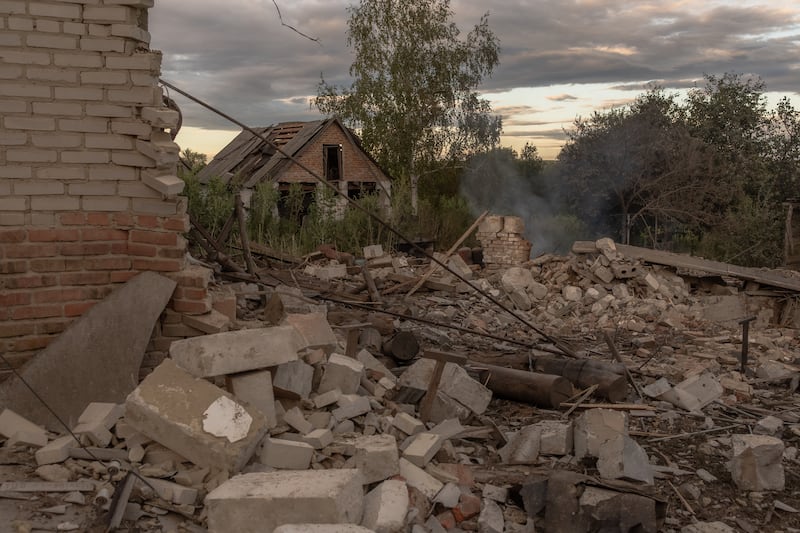President Volodymyr Zelenskiy hailed Ukraine’s “good advance” in Russia’s Kursk region last night, saying Kyiv was achieving its strategic goal in the operation. In his nightly address published on Telegram, Mr Zelenskiy appealed to regional allies to allow long-range strikes on targets inside Russia. “The bolder the partners’ decisions, the less [Russian President Vladimir] Putin can do,” he said.
Mr Zelenskiy made his comments after Ukraine launched what it described as the war’s largest drone attack on Russian airfields as Kyiv’s forces are faced increased resistance nine days into their daring incursion into Russia.
Russia’s defence ministry said on Wednesday that Ukraine had fired 117 drones, as well as missiles, not only in the Kursk region where Ukrainian troops had seized territory, but also in the regions of Voronezh, Belgorod and Nizhny Novgorod. It did not confirm the attacks had targeted its airbases.
“Long-range drones of the security service of Ukraine and defence forces carried out the largest attack on Russian military airfields of the entire war,” said an official in the Ukrainian security service, the SBU.
READ MORE
The official said the airfields of Voronezh, Kursk, Savasleyka and Borisoglebsk had been targeted in order to prevent Russian air attacks on Ukraine.
It was not immediately clear whether any Russian aircraft were damaged or destroyed, and the official said Kyiv was waiting for satellite photos to assess the destruction.
[ The Irish Times view on the Kursk offensive: Ukraine changes the narrativeOpens in new window ]
Meanwhile, the rate at which Ukraine is seizing territory in the Kursk region appears to have slowed.
“We are advancing in the Kursk region, one to two kilometres in various areas since the beginning of the day,” President Mr Zelenskiy said in an earlier statement on Wednesday. He added that Ukrainian forces had “captured more than 100 Russian servicemen” over the previous day.
Ukraine’s top general, Oleksandr Syrsky, said on Monday that Ukrainian forces were holding 1,000sq km of Russian territory. But 24 hours later, he said that they had occupied just a further 40sq km.
Deep State, a Ukrainian analytical group that works closely with the defence ministry, has put the total at 800sq km, but has mapped only 330sq km in order to not give away sensitive Ukrainian positions.
The group’s co-founder, Roman Pohorilyi, said the area under Ukrainian control was close to Gen Syrsky’s estimate.
“[The] Muscovites are disoriented, they do not fully understand what is happening,” said Mr Pohorilyi. He added that the secrecy about the exact Ukrainian positions helped keep Russians in the dark.

The Russian defence ministry on Wednesday said its forces had stopped Ukrainian vehicles from breaking through “deep into Russian territory” in several areas. Moscow said it destroyed two convoys headed north of Sudzha – a town now under Ukrainian control, according to Kyiv.
Russia has scrambled to contain the Ukrainian incursion, with Mr Putin calling it a “provocation” and pledging a “worthy response”. Ukraine’s deputy prime minister, Iryna Vereshchuk, said on Wednesday that it would organise humanitarian corridors for Russian civilians wanting to leave for either Russia or Ukraine.
In the Kursk region, more than 121,000 residents were evacuated from the border area in the first week, according to its acting governor, Alexei Smirnov. The displaced residents might be temporarily housed in the part of Ukraine’s Zaporizhzhia region that Russia occupied in 2022, Smirnov added.
An “antiterrorist” operation was declared on August 9th by Russia’s central authorities for Belgorod, Bryansk, and Kursk regions, all of which border Ukraine. This allows the authorities to restrict movement of residents and gives the security services full access to the area.
Kursk’s neighbouring Belgorod region on Wednesday declared a state of emergency and increased civilian evacuations. Belgorod, which was raided briefly by pro-Kyiv militias in June 2023, has been shelled for more than a year, according to governor Vyacheslav Gladkov.
“The situation in the Belgorod region continues to be extremely difficult and tense,” said Gladkov.
Mr Zelenskiy said the operation aimed to put “pressure” on Russia and pre-empt further attacks on the Ukrainian border region of Sumy.
Ukraine’s general staff said its troops shot down a Russian Su-34 bomber jet “during a combat mission” in the Kursk region early on Wednesday. The Russian bombers are used to drop massive glide bombs on Ukrainian military positions and civilian infrastructure.
Mr Putin earlier this week accused Mr Zelenskiy of seeking to use the seized territory as a bargaining chip in any upcoming peace talks. A spokesman for Ukraine’s foreign ministry said Kyiv did not plan to hold the captured land.
Analysts said another Ukrainian goal was to force Moscow to redeploy troops from Ukraine’s eastern Donetsk region, where Russia is slowly making gains. So far there is no evidence that is happening, as Russian reinforcements have come from the mainland.
Russian foreign ministry spokeswoman Maria Zakharova said on Wednesday that Kyiv “has not achieved the main goal of the attack on the Kursk region – to divert Russian troops”.
Analysts and some Ukrainian soldiers have expressed concern that Kyiv’s decision to redirect some of its most elite units to Kursk could weaken defences in strategically important areas.
On Wednesday, Mr Zelenskiy attempted to assuage those concerns.
“We are not forgetting our eastern front for a second,” he said. “I have instructed the commander-in-chief to strengthen this direction using the equipment and supplies currently provided by our partners.” – Copyright The Financial Times Limited 2024/Additional reporting: Reuters
(c) Copyright Thomson Reuters 2024











